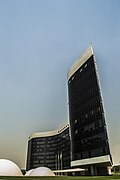Early works (1930s)

- 1936 – Gustavo Capanema Palace, Ministry of Education and Health, Rio de Janeiro – contributed to the Le Corbusier project.
- 1937 – Associação Beneficente Obra do Berço (Association of Charitable Work) – created a vertical brise soleil.
- 1938 – Grande Hotel of Ouro Preto
- 1939 – Brazil's pavilion at the 1939 New York World's Fair – contributed to the Lucio Costa project.































